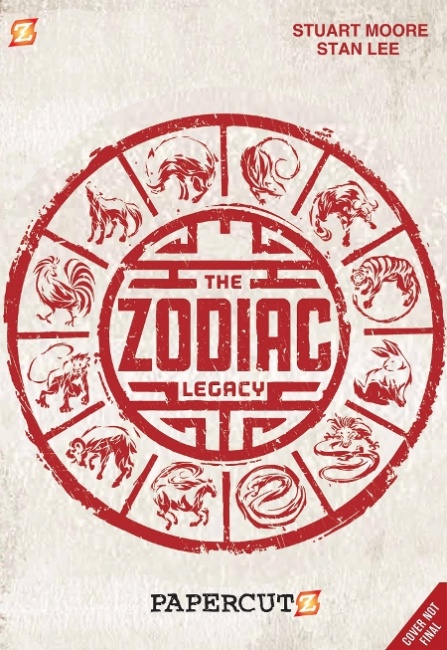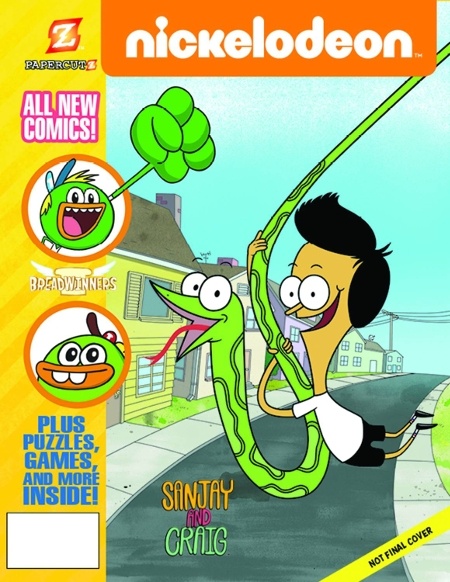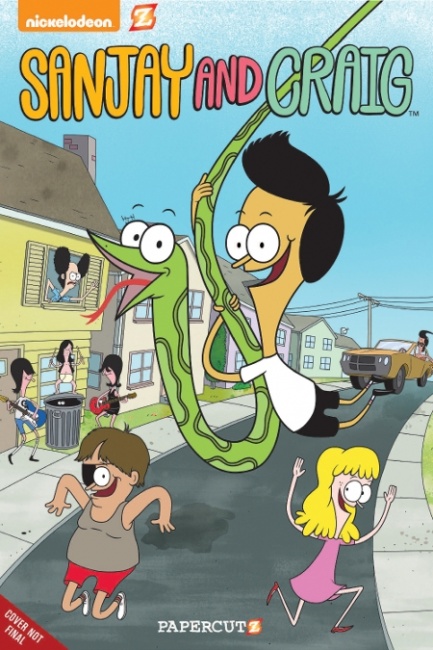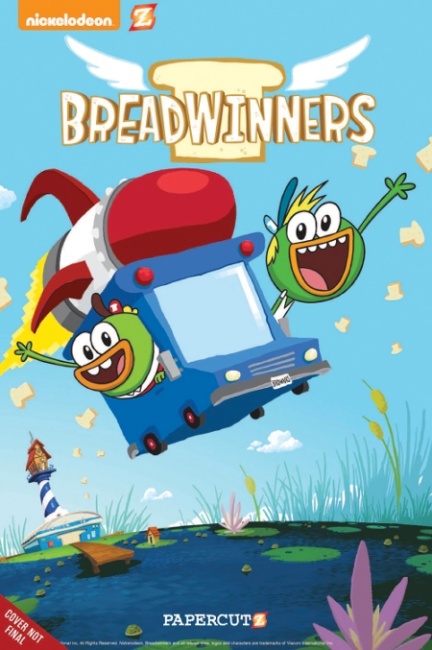We recently caught up with Papercutz Publisher Terry Nantier and Editor-in-Chief Jim Salicrup to talk about the changes they’ve seen in the market for kids graphic novels since they founded the company 10 years ago and their plans for the future. In Part 1, we talk about the market for kids titles, the changes at Papercutz, and which titles are working the best. In Part 2, we talked about the publisher’s plans for Fall, including a graphic novel adaptation of Stan Lee’s The Zodiac Legacy, a new Disney Graphic Novels series, classic Dennis the Menace collections, the launch of Nickelodeon Magazine and comics, and more (with previously unreleased images).
Click any image for larger view.
The Zodiac Legacy sounds interesting.
Salicrup: Disney owns that property so we’re expanding what we’re doing with Disney. We’ve been doing Disney Fairies for four or five years. We’ve been sort of flying under the radar. Disney Fairies is one of the series that made the transition from the small size to the large size and continues to keep going. That, we’re very happy with.
Stan Lee created a property called The Zodiac Legacy that has been published by Disney Press as a YA series that’s profusely illustrated. That series is written by Stuart Moore and illustrated by Andie Tong. We got Stuart Moore to work on the graphic novel series of the same property so there’s all that transmedia thing going on where if someone picks up the YA book and then reads the graphic novel it’s not rehashing the same storyline it’s actually moving forward and exploring other aspects of the characters, moving the plot ahead as well. It’s very exciting for us to be involved with that. I couldn’t resist after working for 20 years at Marvel to publish at least one series that’s been created by Stan Lee.
Is that going to be published as a comic or a graphic novel?
Nantier: Graphic novel. Besides that, the expansion with Disney involves also doing some other Disney classic characters.
What other Disney titles are you planning?
Salicrup: We’re doing another graphic novel series with Disney, this one under the umbrella title of Disney Graphic Novels and each volume will be different content. The debut volume is featuring Planes, the second one is Mickey X, which is a series that had been published in Italy for quite a few years that’s putting Mickey Mouse in the sort of paranormal adventures that has developed quite a cult following. I think we’ll be bringing it to America so people can actually read it. Then there’s another series featuring Minnie and Daisy together which will be more girl-oriented. [There’s] another classics adaptation parody series featuring all of the Disney characters. It’s a lot of great material that’s been published by Disney mostly overseas that we’re lucky enough to be able to bring over here.
Can you tell us about Dennis the Menace?
Salicrup: Speaking of cult favorites, it’s a well-known character that’s obviously been around forever. There’s a lot of serious, well respected comic book artists, from the Hernandez Brothers to Fred Hembeck, that are big fans of the old Dennis the Menace comic books separate from the Hank Ketcham comic strip. And even then it sort of divides into two groups where there’s the fans of the Fred Toole and Al Wiseman stories, and there’s also a very strong following for Owen Fitzgerald. We’re going to be publishing that stuff in hardcover 192-page books, with lots of background material, biographical stuff, etc., but giving it the classic kids’ comic treatment that the work of Carl Barks and others have gotten over the years. There’s just a handful of really classic, great kids comics that haven’t been collected yet and the Dennis the Menace stuff is a big piece of that.
Were those comics from Fawcett?
Salicrup: Yes, Fawcett and CBS, and a couple of other companies I hadn’t heard of before.
What do you have to work with in terms of original art?
Salicrup: We’re really starting it now. We may have to scan stuff or we may be able to get stuff from King Features. It remains to be seen. I was just talking with Terry about that today, but I think it’s going to come out beautifully.
King Features?
Salicrup: They own the whole thing [including the comics].
Is the Nickelodeon material launching as comics or graphic novels?
Nantier: We’re doing a monthly magazine first. That’s primarily going into newsstands but also subscriptions as kids magazines marketed that way, then we’re collecting what’s appearing in the magazine in graphic novels.
When you say newsstand, do you mean Barnes & Noble or Kroger?
Nantier: Barnes and Noble magazine stands, but it’ll also be in Walmart and supermarkets. We’re going to have prominent positioning for the launch of this. I think people will be seeing us pretty much everywhere because we’re getting a lot of excitement out there and a lot of positioning in top slots for the launch of this magazine in June.
Salicrup:For many years Nickelodeon published Nickelodeon Magazine, which was sort of a mix of articles, features and a big chunk, maybe 50% comics. Our magazine is closer to over 80% comics. There will still be some activities and short articles and a lot of pages like that, but the majority will be comics based on current shows and new shows going forward based on our deal with Nickelodeon. The early issues will prominently feature Sanjay and Craig as well as the Breadwinners but starting with issue three or four, Harvey Beaks joins the line-up and as the magazine keeps going, more and more characters will be added with each issue. And each of those individual series, as Terry said, will then be collected into their own graphic novel series.
It’s been a few years since Nickelodeon did their magazine. Do you know why they stopped and then decided to have you do it?
Nantier: I think they had a large staff doing this and it was a multi-subject magazine about celebrities, etc. [It was] expensive for them and they weren’t in the magazine business. By 2009 they decided to get out of that. Magazines are a difficult business, there’s no doubt about it. You have to play this very carefully. We’re not looking to create an ad base here, we’re not selling advertising. It’s going to be all content and we’re going to be on a cover price and subscription revenue model, so it’s a different take on this. And for them, they had to concentrate more on what their strength is which is their TV channels, animation and live action shows.
Salicrup: Back when I was at Marvel, with Star Wars I got to learn that distribution is everything. With the first six issues of Star Wars we republished in every possible format: it was treasury editions, mass market paper backs, the actual comic books, bagged comic books, anything that we could have thought of, and sure there were probably some collectors that wanted to get every version, but I think it’s more a way for us to reach audiences we may not be reaching in other places. As Terry said, if it’s in Barnes & Noble, there’s still millions of kids who watch Nickelodeon and may not go to a comic book store.
Every American family is in a supermarket every week.
Salicrup: Exactly, and it’s probably a lot easier as a comics property to stand out in a supermarket as opposed to even book stores and comic book stores. At this point it’s gotten so crowded. Let’s keep our fingers crossed and hope we know what we’re doing.
Anything else that you think our readers should know?
Nantier: We haven’t mentioned this much, except for Lunch Witch, which is a great launch of this, but we are getting into originals here and author-based concepts and series, not just the licensed materials. Lunch Witch is a great first example, but we’ve got a whole line-up of great stuff coming up such as Scarlett, by John Buller and Susan Schade (see “Papercutz Expands OGN Line”).
We also have The Red Shoes, which is an adaptation of fairy tales by Metaphrog, a name that may ring a bell with old fans from their Louis series. And we have further things that we’ll be announcing. We’ve got a baseball-themed book for kids next year and many of these authors are bestselling authors in their own right. They’ve been very successful picture book authors with various series in the past, so we’re quite excited about that direction we’re taking as well.
Maybe kind of turn the whole tables around so that we have something to license as opposed to buying the licenses.
Salicrup: Things like our deal with Nickelodeon and now trying to do more original creations that we’re involved with is maybe the answer to your first question of how have we changed 10 years later. In the very beginning we saw virtually no competition when we were going after kids’ licenses; now it’s become a very competitive field, so this just seems like the right move for us to be doing at this point.
Click here for Part 1.
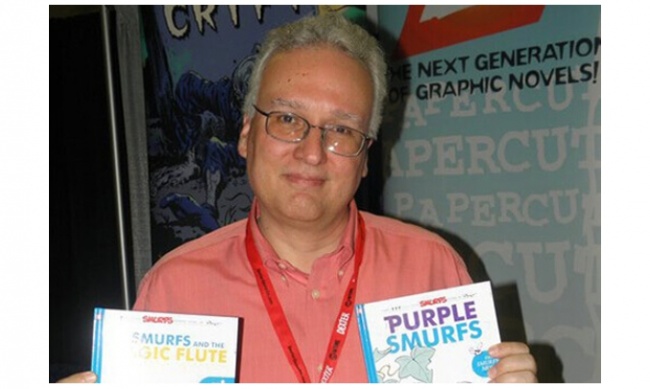
Selling Kids Graphic Novels
Posted by ICv2 on May 6, 2015 @ 2:08 am CT




